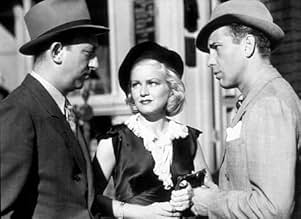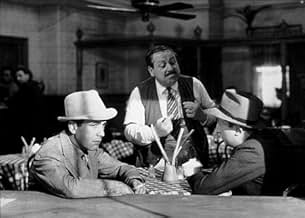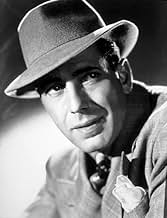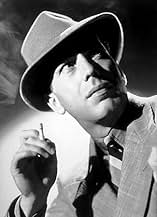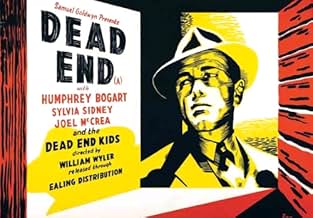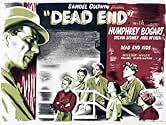NOTE IMDb
7,2/10
9,2 k
MA NOTE
Les vies de deux jeunes gens, d'un notoire gangster et d'une bande d'enfants des rues convergent un jour dans un quartier déshérité instable de New York.Les vies de deux jeunes gens, d'un notoire gangster et d'une bande d'enfants des rues convergent un jour dans un quartier déshérité instable de New York.Les vies de deux jeunes gens, d'un notoire gangster et d'une bande d'enfants des rues convergent un jour dans un quartier déshérité instable de New York.
- Réalisation
- Scénario
- Casting principal
- Nommé pour 4 Oscars
- 1 victoire et 4 nominations au total
Leo Gorcey
- Spit
- (as Leo B. Gorcey)
Avis à la une
It offers a vivid portrait of people caught up in a continual fight to somehow satisfy themselves despite the oppressive environment that seemed to quiet their every attempt
Joel McCrea is a frustrated architect who dreams of tearing down the slums and Sylvia Sidney portrays a shopgirl struggling for identity and meaning in her life, a life made even more complicated by having to look after her brother (Billy Halop). The boy idolizes the decadent Bogart, an excessive admiration shared by the rest of the Dead End Kids, here recreating their original Broadway roles with noisy good humor
Opposing these idealists is their real threat, Bogart, an assassin named Baby Face Martin Bogart is impolitely rejected by a mother (Marjorie Main) who hates him and an ex-girl friend (Claire Trevor) who leaves him bitter and disillusioned when he discovers that she has become a hooker
Rebuked by those he had been sentimental enough to want to visit, he rapidly reverts to represent beforehand and plans a kidnapping in order to rescue something from the consumed affair
"Dead End" remains one of Bogart's best films, where the actor proves that he is capable of handling difficult material with considerable skill
Joel McCrea is a frustrated architect who dreams of tearing down the slums and Sylvia Sidney portrays a shopgirl struggling for identity and meaning in her life, a life made even more complicated by having to look after her brother (Billy Halop). The boy idolizes the decadent Bogart, an excessive admiration shared by the rest of the Dead End Kids, here recreating their original Broadway roles with noisy good humor
Opposing these idealists is their real threat, Bogart, an assassin named Baby Face Martin Bogart is impolitely rejected by a mother (Marjorie Main) who hates him and an ex-girl friend (Claire Trevor) who leaves him bitter and disillusioned when he discovers that she has become a hooker
Rebuked by those he had been sentimental enough to want to visit, he rapidly reverts to represent beforehand and plans a kidnapping in order to rescue something from the consumed affair
"Dead End" remains one of Bogart's best films, where the actor proves that he is capable of handling difficult material with considerable skill
This movie is not only a great story, it is a great social commentary on the divisions between rich and poor. The main story concerns the return of a gangster to his old neighborhood, but a couple of side stories concern the gang of kids who seemingly idolize the hood and the rich people who live in a luxury apartment that is next to the slum. This film could be made today because the conditions that are in the film still exist today only they are a hundred times worse because the gap between the rich and the poor in this country have widened even more. This film should be shown more on television
Now here's a fascinating world from the late 1930s, where they're not really angels but they still have faces dirty, where the rich butt up with poor, as they wander through their backdoor, and the disconnect provokes and displeases. The kids of the Dead End are always causing trouble, as they live their lives in a ghetto like bubble, observed by 'Baby Face' Martin, who's returned to be disheartened, this villain prefers knife over knuckle. You're left with a feeling that the worlds on the cusp, a self-destructive nature that might leave it in dust, but four years later a falcon will rise, and a year after that a white house will surprise.
i'm a huge Bogey fan, so naturally i'll watch anything with his name in the credits. however, i was not prepared for "dead end." this is one of the most brilliant films i've ever seen and i can't understand why the eberts and roepers and maltins never talk about this one. it begins as a familiar story, rich vs. poor along the east river. a gang of kids hang around outside the ritzy, new apartments in the neighborhood. tommy, it's leader and his "friends" notice a boy who has been earning pocket money as a babysitter. when tommy steals his money, a fight breaks out. off in the distance, two men in silk suits watch the fight. tommy's sister drina breaks up the fight. drina is a working class woman on strike, trying to earn the money she deserves. Dave is her on-again, off-again love interest who has done everything in the book to try to rise out of poverty, but still can't get ahead. Dave has been seeing Kay, a young woman torn between a future with a man she thinks she may love (Dave) and the comforts of wealth. we find out the two men in silk suits are gangsters, one being the famous killer, baby face martin, who has returned to his home to see his mother and old girlfriend. he is rejected by his mother, who is disgusted by his profession and track record and his girlfriend, who has become a common prostitute. their are a million intertwining story lines that add up to one incredible climax, but essentially this film is about the cycle of poverty and class issues. the performances are terrific. Sylvia Sidney (not a big name today, but a damn good actress) and Joel mccrea are perfection as the films heroes. Bogart is unforgettable. this is one of the dozens of gangsters he played, but i would rate this performances as high as duke manatee in petrified forest. he's tough and street smart, but with each disappointment we see evidence of his emotions leaking out. the gang of kids remind me of the jets in west side story- they don't like anyone, not even each other half the time. look for Marjorie main (ma kettle before she was ma kettle!) in a touching, but heartbreaking scene as Bogey's frail, aging mother and Claire Trevor (another fine, forgotten actress) as Bogey's sweetheart turned greedy streetwalker. the best thing about this film is they way each character believes he or she can overcome the way of life he or she seems fated to live with. each character tries desperately and fails. this is the way real people are. there's no Hollywood, sugar-coatedness about any of it. no over-dramatic music or made-for-the-previews lines. it's grossly realistic. this film would be on my top 50 list, maybe even my top 25. it's that good.
Dead End the film adaption of Sidney Kingsley's play that ran for 687 performances during the 1935-1937 seasons, was a harbinger of what Alfred Hitchcock tried to do in such films as Rope and even more so in Rear Window. The whole story is told on one very complex set showing the stark contrast of the rich penthouse dwellers with the inhabitants of the nearby tenements and flats.
Building that set on stage and for the screen must have been one expensive proposition so it was a good thing Sidney Kingsley wrote a hit.
It may be one set, but the plot of the film involves three stories and how they interconnect. Story number one is about Joel McCrea, a former slum kid himself who still lives down there while he tries to get a job as an architect. He's involved with two women, rich socialite Wendy Barrie who lives in the penthouse and Sylvia Sidney who played more working class women than anyone else during the Thirties.
Sidney works as a seamstress in a garment factory and she's currently on strike and she's got a younger brother to support who causes her much grief. The younger brother is Billy Halop and Sidney worries about the gang he runs with, the kids who later became known as the Dead End kids, later East Side Kids, later Bowery Boys. Their a rough bunch and they get a visit from a celebrity of sorts.
Which leads us to the third track in the person of Humphrey Bogart who grew up on this same block and is now a wanted fugitive of the John Dillinger variety. The kids and McCrea recognize him, the kids worship him and McCrea is willing to give him a pass for now, he's no rat. All their stories mix in this plot which does hold the interest through out the film.
Besides the Dead End Kids who didn't all play the same roles you see them play on the screen only one other player came over from Broadway for the screen version. Marjorie Main who we usually know as the rambunctious and brassy Ma Kettle plays a very serious part indeed as Humphrey Bogart's mother. You'll not forget her as she rejects her hoodlum son both the anger and sorrow she expresses, it is haunting.
Bogart got another jolt in his trip down memory lane in the slum in the person of Claire Trevor. She's usually a good time girl with a heart of gold. Her heart may be golden in Dead End, but she's a woman who's seen the seamy side of life as a prostitute. Very few prostitutes were portrayed as such during the days of The Code so in that sense Dead End was quite daring.
The film is firmly set in the Depression Thirties. That same area where in certain shots you can see the Queensborough Bridge in the near distance is some of the richest real estate on earth now. Those same buildings that are portrayed as slums now rent to yuppies at obscene figures if in fact they survived.
Though Dead End is a dated piece of work, it does offer a great glimpse into urban life for the rich and poor. This is one of Samuel Goldwyn's best productions and William Wyler gets uniformly fine performances from his talented cast of players.
Building that set on stage and for the screen must have been one expensive proposition so it was a good thing Sidney Kingsley wrote a hit.
It may be one set, but the plot of the film involves three stories and how they interconnect. Story number one is about Joel McCrea, a former slum kid himself who still lives down there while he tries to get a job as an architect. He's involved with two women, rich socialite Wendy Barrie who lives in the penthouse and Sylvia Sidney who played more working class women than anyone else during the Thirties.
Sidney works as a seamstress in a garment factory and she's currently on strike and she's got a younger brother to support who causes her much grief. The younger brother is Billy Halop and Sidney worries about the gang he runs with, the kids who later became known as the Dead End kids, later East Side Kids, later Bowery Boys. Their a rough bunch and they get a visit from a celebrity of sorts.
Which leads us to the third track in the person of Humphrey Bogart who grew up on this same block and is now a wanted fugitive of the John Dillinger variety. The kids and McCrea recognize him, the kids worship him and McCrea is willing to give him a pass for now, he's no rat. All their stories mix in this plot which does hold the interest through out the film.
Besides the Dead End Kids who didn't all play the same roles you see them play on the screen only one other player came over from Broadway for the screen version. Marjorie Main who we usually know as the rambunctious and brassy Ma Kettle plays a very serious part indeed as Humphrey Bogart's mother. You'll not forget her as she rejects her hoodlum son both the anger and sorrow she expresses, it is haunting.
Bogart got another jolt in his trip down memory lane in the slum in the person of Claire Trevor. She's usually a good time girl with a heart of gold. Her heart may be golden in Dead End, but she's a woman who's seen the seamy side of life as a prostitute. Very few prostitutes were portrayed as such during the days of The Code so in that sense Dead End was quite daring.
The film is firmly set in the Depression Thirties. That same area where in certain shots you can see the Queensborough Bridge in the near distance is some of the richest real estate on earth now. Those same buildings that are portrayed as slums now rent to yuppies at obscene figures if in fact they survived.
Though Dead End is a dated piece of work, it does offer a great glimpse into urban life for the rich and poor. This is one of Samuel Goldwyn's best productions and William Wyler gets uniformly fine performances from his talented cast of players.
Le saviez-vous
- AnecdotesWilliam Wyler gave Claire Trevor an old purse and broken high heel shoes. He had her minimize her make-up and ordered her not to comb her hair when she got up in the morning. He wanted her to look like the downtrodden character she was playing.
- GaffesBaby Face Martin suddenly appears from nowhere and is leaning against a railing as the boys are fighting.
- Crédits fousOpening credits prologue: Every street in New York ends in a river. For many years the dirty banks of the East River were lined with the tenements of the poor. Then the rich, discovering that the river traffic was picturesque, moved their houses eastward. And now the terraces of these great apartment houses look down into the windows of the tenement poor.
- ConnexionsFeatured in AFI Life Achievement Award: A Tribute to William Wyler (1976)
- Bandes originalesBoo-Hoo
(1937) (uncredited)
Music by Carmen Lombardo and John Jacob Loeb
Lyrics by Edward Heyman
Played at the upstairs party and sung by Huntz Hall in the street
Meilleurs choix
Connectez-vous pour évaluer et suivre la liste de favoris afin de recevoir des recommandations personnalisées
- How long is Dead End?Alimenté par Alexa
Détails
Box-office
- Budget
- 300 000 $US (estimé)
- Durée1 heure 33 minutes
- Couleur
- Rapport de forme
- 1.37 : 1
Contribuer à cette page
Suggérer une modification ou ajouter du contenu manquant

Lacune principale
By what name was Rue sans issue (1937) officially released in India in English?
Répondre

